Related Research Articles
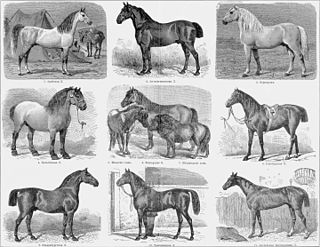
A horse breed is a selectively bred population of domesticated horses, often with pedigrees recorded in a breed registry. However, the term is sometimes used in a broader sense to define landrace animals of a common phenotype located within a limited geographic region, or even feral "breeds" that are naturally selected. Depending on definition, hundreds of "breeds" exist today, developed for many different uses. Horse breeds are loosely divided into three categories based on general temperament: spirited "hot bloods" with speed and endurance; "cold bloods," such as draft horses and some ponies, suitable for slow, heavy work; and "warmbloods," developed from crosses between hot bloods and cold bloods, often focusing on creating breeds for specific riding purposes, particularly in Europe.

Horse breeding is reproduction in horses, and particularly the human-directed process of selective breeding of animals, particularly purebred horses of a given breed. Planned matings can be used to produce specifically desired characteristics in domesticated horses. Furthermore, modern breeding management and technologies can increase the rate of conception, a healthy pregnancy, and successful foaling.

The Akhal-Teke is a Turkmen horse breed. They have a reputation for speed and endurance, intelligence, and a distinctive metallic sheen. The shiny coat of the breed led to their nickname, "Golden Horses". These horses are adapted to severe climatic conditions and are thought to be one of the oldest existing horse breeds. There are currently about 6,600 Akhal-Tekes in the world, mostly in Turkmenistan, although they are also found throughout Europe and North America. Akhal is the name of the line of oases along the north slope of the Kopet Dag mountains in Turkmenistan. It has been inhabited by the Tekke tribe of Turkmens.

The Arabian or Arab horse is a breed of horse with historic roots on the Arabian Peninsula. With a distinctive head shape and high tail carriage, the Arabian is one of the most easily recognizable horse breeds in the world. It is also one of the oldest modern breeds. Although modern DNA cannot trace breed purity in the modern population beyond 200 years, there is archaeological evidence of horses in the Middle East with landrace characteristics that resemble modern Arabians dating back 3,500 years. Throughout history, Arabian horses have spread around the world by both war and trade, used to improve other breeds by adding speed, refinement, endurance, and strong bone. Today, Arabian bloodlines are found in almost every modern breed of riding horse.

A Hanoverian is a Warmblood horse breed originating in Germany, which is often seen in the Olympic Games and other competitive English riding styles, and has won gold medals in all three equestrian Olympic competitions. It is one of the oldest, most numerous, and most successful of the Warmblood breeds. Originally a cavalry horse, infusions of more Thoroughbred blood lightened it to make it more agile and useful for competition. The Hanoverian is known for a good temperament, athleticism, beauty, and grace.
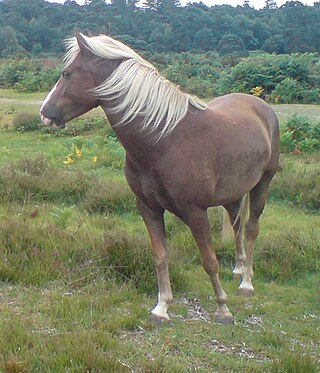
The New Forest pony is one of the recognised mountain and moorland or native pony breeds of the British Isles. Height varies from around 12 to 14.2 hands ; ponies of all heights should be strong, workmanlike, and of a good riding type. They are valued for hardiness, strength, and sure-footedness.

The Canadian is a horse breed from Canada. It is a strong, well-muscled horse, usually dark in colour. It is generally used for riding and driving. Descended from draft and light riding horses imported to Canada in the late 1600s from France, it was later crossed with other British and American breeds. During the 18th century the Canadian horse spread throughout the northeastern US, where it contributed to the development of several horse breeds. During the peak popularity of the breed, three subtypes could be distinguished, a draft horse type, a trotting type and a pacing type. Thousands of horses were exported in the 19th century, many of whom were subsequently killed while acting as cavalry horses in the American Civil War. These exports decreased the purebred Canadian population almost to the point of extinction, prompting the formation of a studbook and the passage of a law against further export.
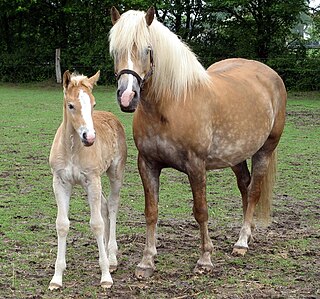
The Haflinger, also known as the Avelignese, is a breed of horse developed in Austria and northern Italy during the late 19th century. Haflinger horses are relatively small, are always chestnut with flaxen mane and tail, have distinctive gaits described as energetic but smooth, and are well-muscled yet elegant. The breed traces its ancestry to the Middle Ages; several theories for its origin exist. Haflingers, developed for use in mountainous terrain, are known for their hardiness. Their current conformation and appearance are the result of infusions of bloodlines from Arabian and various European breeds into the original native Tyrolean ponies. The foundation sire, 249 Folie, was born in 1874; by 1904, the first breeders' cooperative was formed. All Haflingers can trace their lineage back to Folie through one of seven bloodlines. World Wars I and II, as well as the Great Depression, had a detrimental effect on the breed, and lower-quality animals were used at times to save the breed from extinction. During World War II, breeders focused on horses that were shorter and more draft-like, favored by the military for use as packhorses. The emphasis after the war shifted toward animals of increased refinement and height.
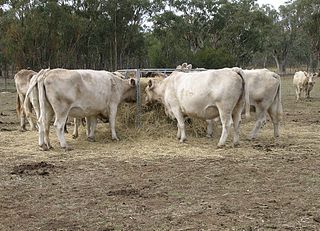
A stud animal is a registered animal retained for breeding. The terms for the male of a given animal species usually imply that the animal is intact—that is, not castrated—and therefore capable of siring offspring. A specialized vocabulary exists for de-sexed animals and those animals used in grading up to a purebred status.

A stallion is a male horse that has not been gelded (castrated). Stallions follow the conformation and phenotype of their breed, but within that standard, the presence of hormones such as testosterone may give stallions a thicker, "cresty" neck, as well as a somewhat more muscular physique as compared to female horses, known as mares, and castrated males, called geldings.

A stud farm or stud in animal husbandry is an establishment for selective breeding of livestock. The word "stud" comes from the Old English stod meaning "herd of horses, place where horses are kept for breeding". Historically, documentation of the breedings that occur on a stud farm leads to the development of a stud book. Male animals made available for breeding to outside female animals are said to be "standing at stud", or at "stud service", referencing the relatively high probability that they are kept at a stud farm.
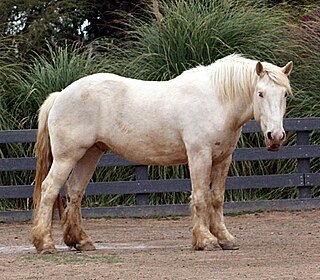
The American Cream Draft is an American breed of draft horse, characterized by the cream or "gold champagne" color of its coat. It was developed in Iowa during the early twentieth century from a cream-colored mare named Old Granny. A breed registry was formed in 1944 but became inactive for several decades when breed numbers dropped due to the mechanization of farming. It was reactivated in 1982 and population numbers have slowly grown since then. It is a rare breed: its conservation status is considered critical by The Livestock Conservancy and the Equus Survival Trust.
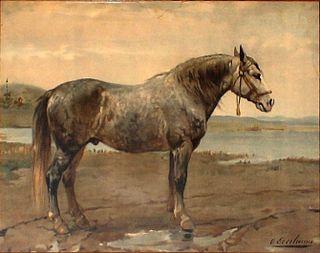
The Russian Draft or Russian Heavy Draft is a Russian breed of draft horse. It was bred in Imperial Russia in the second half of the nineteenth century, and until after the Russian Revolution was known as the Russian Ardennes. It is one of a number of draft breeds developed there at approximately the same time, others being the Lithuanian Heavy Draft, the Soviet Heavy Draft and the Vladimir Heavy Draft; it is both the oldest and the smallest of them. The present name dates from the Soviet era, and was used from 1952.

The Poitevin or Poitou is a French breed of draft horse. It is named for its area of origin, the former province of Poitou in west-central France, now a part of the region of Nouvelle-Aquitaine. It was formed in the seventeenth century when horses of Flemish or Dutch origin, brought to the area by engineers working to drain the Marais Poitevin, interbred with local horses. Although it has the size and conformation of a draft horse, the Poitevin has never been bred for draft abilities, and has been little used for draft work. Its principal traditional use was the production of mules. Poitevin mares were put to jacks of the large Baudet du Poitou breed of donkey; the resulting Poitevin mules were in demand for agricultural and other work in many parts of the world, including Russia and the United States. In the early twentieth century there were some 50,000 brood mares producing between 18,000 and 20,000 mules per year.

Mountain and moorland ponies form a group of several breeds of ponies and small horses native to the British Isles. Many of these breeds are derived from semi-feral ponies kept on moorland or heathland, and some of them still live in this way, as well as being kept as fully domesticated horses for riding, driving, and other draught work, or for horse showing.

The Zweibrücker is a type of German warmblood horse bred in Rhineland-Palatinate and Saarland. Traditionally, the breeding of Zweibrücken was centered on the onetime Principal Stud of Zweibrücken but since 1977 has been under the jurisdiction of the Horse Breeders' Association of Rhineland-Palatinate-Saar (PRPS). The modern Zweibrücker is an elegant, large-framed, correct sport horse with powerful, elastic gaits suitable for dressage, show jumping, eventing and combined driving.
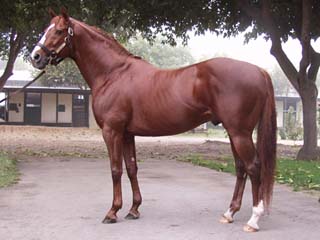
The Thoroughbred is a horse breed developed for horse racing. Although the word thoroughbred is sometimes used to refer to any breed of purebred horse, it technically refers only to the Thoroughbred breed. Thoroughbreds are considered "hot-blooded" horses that are known for their agility, speed, and spirit.

The Yeguada Militar de Jerez de la Frontera, known outside Spain as the Yeguada Militar, is a military Spanish stud farm headquartered in Andalusia, Spain, dedicated to horse breeding of purebred Andalusian horses and Arabian horses. Founded in 1847, it became the state military stud farm in 1893. In the 20th century, as need for cavalry horses declined, the stud's emphasis shifted to become a genetic reservoir to preserve the bloodlines of the Pure Spanish Horse and to continue to breed high quality Arabian horses, with stallions of both breeds being made available to private horse breeders to improve the horses of Spain. Today, there are two facilities located in the Jerez de la Frontera area, one primarily for stallions, the other for mares and foals, as well as multiple stallion depots across the country.

Black Allan or Allan F-1 was the foundation sire of the Tennessee Walking Horse. He was out of a Morgan and Thoroughbred cross mare named Maggie Marshall, a descendant of Figure and the Thoroughbred racing stallion Messenger; and sired by Allandorf, a Standardbred stallion descended from Hambletonian 10, also of the Messenger line.

The Strelets Arab or Strelets Horse is an extinct Ukrainian breed of light cavalry horse. It was bred in the nineteenth century at the Striletsky State Stud in Luhansk Oblast of Ukraine, from Arab and a variety of other stock. As with other Russian horse populations, its numbers were gravely reduced by the events of the Russian Revolution and the Russian Civil War, and it came close to disappearing. Two stallions and a few mares survived, which was judged to be too small a number to allow the breed to be recovered. Instead, they were taken to the Tersk Stud in the North Caucasus and used as the foundation stock in the development of the new Tersk breed of riding horse. The Strelets also contributed to the development of the Don and Kustanai breeds.
References
- ↑ Beason v. Ashford Stud, Kentucky Court of Appeals, Unpublished, 2004 WL 758341 (While this opinion related to payment for stallion services, it does cite the common industry definition of a live foal.)